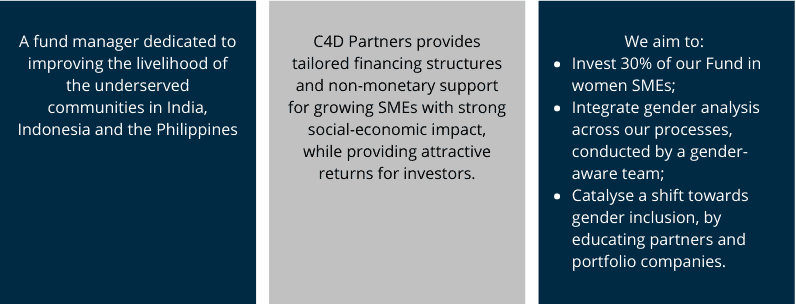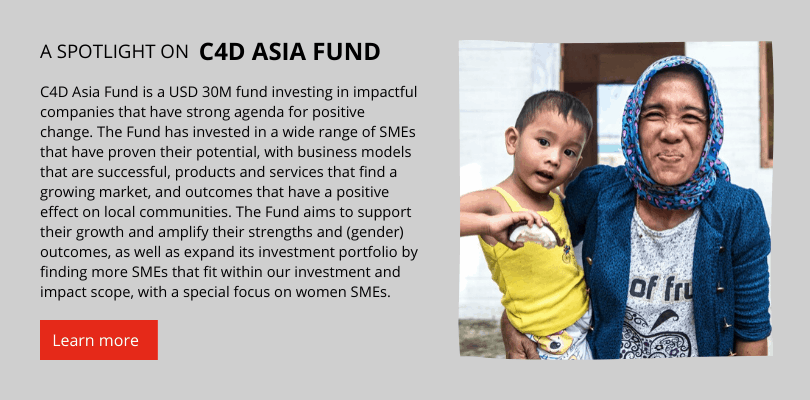4 min read
“Gender lens investing entails far more than investing in women. By unleashing women’s economic participation, be it as entrepreneurs, employees, or others, there will be economic and social benefits to not only women, families and communities, but also to their country’s economic development.” – Marcel Neutel, Partner
What motivated you to become a gender lens investor?
Whether they are entrepreneurs, employees, consumers, or suppliers, women are often in disadvantaged positions in society. These disadvantages are not only confirmed by a wide range of studies, but also witnessed within the companies we have been investing in as well as in the communities we were trying to support. When we were in the process of designing our new impact investing fund, we deepened our awareness and knowledge of gender lens investing (GLI). These learning made us see GLI as an opportunity instead of a limitation.
We initially thought it would be tricky to find sufficient women SMEs or we might leave out promising men-led/owned SMEs due to selection bias. However, after we scouted the markets we operate in, we came to know that investable women SMEs are out there and that they are in great need for suitable growth capital. Just a year after launching the Fund, we are seeing promising women SMEs coming on board.
We are, nonetheless, not limited to investing in women SMEs, as we also welcome SMEs that are owned and/or managed by men. Even if a SME is not a women SME (meaning that less than 50% is owned by a woman, and/or less than 50% of its management is female), we continue to assess how gender plays a role in the business, supply chain and company’s ecosystem. In our view, gender plays a role in every corner of the economy and society.
What guides your investment decisions? Have you seen any returns?
We apply an impact lens and a gender lens during our initial investment selection phase. Companies need to create positive impact in the lives of underserved communities, and we prefer investing in women SMEs.
In the year since the launch of our C4D Asia Fund, we have made strides towards incorporating a gender lens in our investing strategy and across our operations. We committed time and resources towards making gender inclusion a core priority for our business, and have developed a formal gender strategy for our organisation. As our team becomes more gender aware, we are constantly improving our approach to integrate gender more holistically across the board, workplace and value chain by educating investment partners and portfolio companies. For a start, we have developed a gender self-assessment toolkit which will which will serve as an introductory point for a structured conversation about gender with the companies. Moving forward, we also intend to include gender into our screening and due diligence processes.
Thus far, we have invested in 23 companies, of which 8 are women SMEs. In terms of the allocation of our Fund’s assets, we have allocated more than 35% to women SMEs. The Fund also promotes gender inclusion among all investees, including those which are not women-led.
What are the challenges and opportunities in encouraging more mainstream businesses and investors in joining the gender lens ecosystem?
While we are excited to engage investees on gender in open conversations, it is a challenge to do so beyond the necessary reporting requirements. Our team does not have gender experts, hence it is tricky to identify which aspects of gender to emphasize. Secondly, we worry that these types of conversations run the risk of overburdening our investees who already face myriad business-related concerns. As GLI is not a common approach, it is particularly hard to navigate through complex gender dynamics in each country and company, as their nuances play out differently from context to context. As gender bias varies across different cultures and communities, these inequalities will take time to change.
To address these challenges, we have partnered with advisors like Value 4 Women and Criterion, whose expertise are crucial for us to better understand how to look at gender issues and address them. We have also taken steps to implement gender inclusion principles internally by diversifying the C4D team and Investment Committee. As a result, C4D Partners has moved from an all-male to a more balanced workforce.
Despite seeing more interest in GLI throughout the investment community, the ecosystem is still small and it will take more time, evidence and convincing to bring real change. We are also encouraging more training and research to build up a common language, database and compelling business case for investees and investors to apply a gender lens to their business.
What are your tips for new or interested entrants to gender lens investing?
GLI is a topic that needs learning and commitment. So, think about whether you are serious and authentic when diving into gender issues.
Integrating gender in business practice has the potential to improve a company, financially and meaningfully; There is no trade-off. Gender plays a role in every company, sector, supply chain and economy. By only focusing on women-led companies, you fall short of addressing gender issues and you are not leveraging your position as an involved investor to the fullest. If you can’t hire a gender expert on your team, you’ll have to find expertise and support externally to bust myths and learn best practices.
How can AVPN support the work that you do?
We hope to encourage our network to become more informed and aware of gender issues to change gender dynamics in a positive way. AVPN is the perfect platform to make people (more) aware of gender dynamics, gender discrimination, and how investors can address these challenges.
We will love to know who else is focusing on gender balance and justice, and connect with them to exchange ideas, findings and experiences. Learn about this community.




















